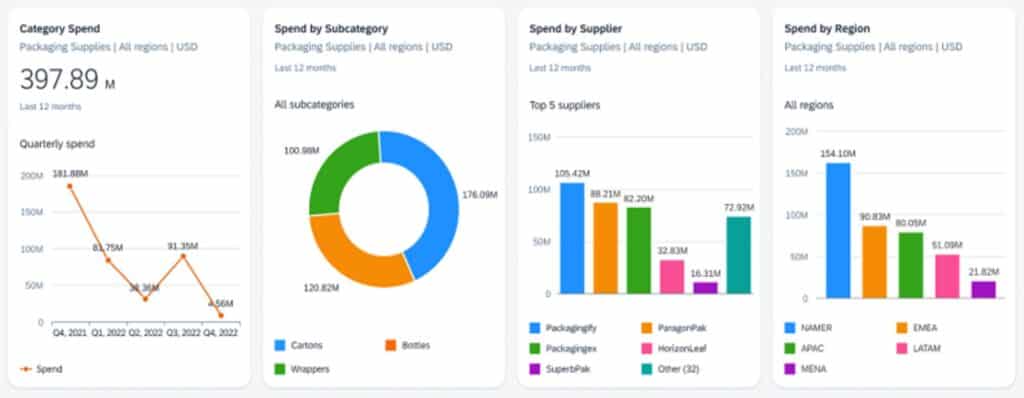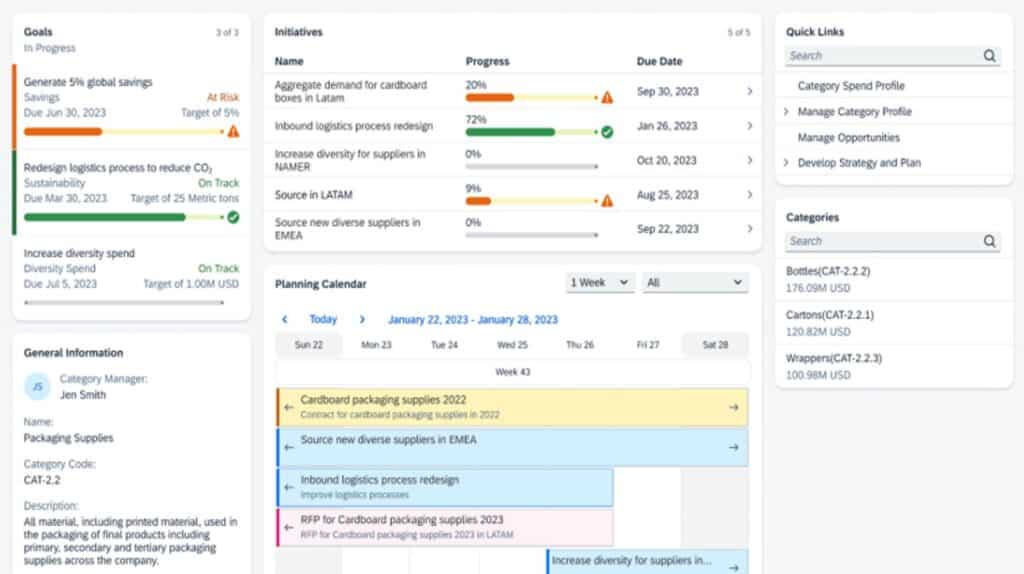Category management is having its digital moment.
For too long, category managers have been saddled with manual data collection processes that inhibit strategic thinking and execution. That’s because vital information is often scattered across a variety of software applications, databases, and third parties – and hidden among hundreds of spreadsheets and presentations. Making things worse, data is captured in disparate category frameworks, so it’s difficult – if not impossible – to analyze or compare.
Enough is enough. Category management professionals are more than ready for change, as are C-level executives. In just-released research by Economist Impact, sponsored by SAP, we asked 500 executives – including chief financial officers, chief operations officers, chief procurement officers, chief supply chain officers, and chief human resources officers – for their thoughts about the need for change in category management.
These executives ranked category management among the top drivers of digital transformation in procurement – which is consistent with what a similar group said in our 2022 study. Additionally, nearly a third view category management as the top technological trend to implement in the coming year.
SAP’s development of procurement solutions continues to be guided by research like the studies referenced here. With this in mind, our team has developed a new solution that helps digitalize and streamline the development, execution, and monitoring of category strategies.
Introducing SAP Category Management
At SAP Sapphire, we introduced SAP Category Management,* a solution that helps procurement teams move away from manual tracking and presentation tools. It can enable category managers to use data strategically to identify trends, develop and execute strategies, and measure success against real business metrics. The solution is planned to be available in August 2023.
*Now SAP Ariba Category Management, the solution is generally available as of August 2023.
SAP Category Management can support our customers with:
- In-depth insights to help form a cohesive category strategy
- Embedded market dynamics and category intelligence
- Consistent category management frameworks across regions
- Opportunity analysis and recommendations
- Resilience and agility in the face of supply chain disruptions
- Integration with SAP Ariba solutions
Watch a demo of SAP Category Management.
Intelligence-Driven Category Management
To show how SAP Category Management can help your organization deploy true intelligence-driven tools and processes, let’s look at how the solution fits within the steps of the category management process.
1. Define Product and Service Categories
The process starts by defining logical and manageable product and service categories. Usually, this is a manual process. And, since managers often use different classification schemes and taxonomies, categorization can be inconsistent or inaccurate.
SAP Category Management can provide a consolidated purchasing category taxonomy, which acts as a uniform, company-wide scheme to classify goods and services. This helps make category definition harmonized and transparent, creating a solid base for analysis, planning, and execution of category strategies.
2. Gather Facts about Organizational Spend
Before you can have a category management strategy, you need to collect data on your past spend, prices, suppliers, markets, regulations, and risks. This information is usually dispersed across different solutions, databases, reports, and third parties in a variety of formats.
Category managers spend way too much time collecting and consolidating data to create an “as-is” picture of the category. This data is often collected manually and kept in hundreds of slides and spreadsheets. And, because the whole process takes so long, data can become outdated.
SAP Category Management can provide a 360-degree view of the category. This can give managers an instant view of category spend, as well as spend by subcategories, suppliers, and regions.

SAP Category Management includes embedded category analytics and integrated, third-party market intelligence and benchmarks.
The solution can deliver built-in integration with the SAP Ariba Spend Analysis solution, which helps provide enriched and categorized spend data. However, customers that manage their categorized spend in other systems can also integrate this data into SAP Category Management.
3. Strategize and Plan
Today, category planning is a time-consuming, manual process which, as a result, is done less frequently than it should be. Its sheer complexity often results in lost opportunities to execute programs that would help the organization achieve goals like cost savings and increased sustainability.
Here are some key challenges:
- Category managers analyze data within a variety of different frameworks, which can yield inconsistent metrics. As a result, the quality of their analysis and resulting strategies can vary widely.
- Teams use different methods to generate opportunities to achieve category goals.
- Calculating the benefits of a particular strategy can be time-consuming.
- Category plans are documented in isolated spreadsheets, which makes it difficult to communicate and collaborate with stakeholders.
SAP Category Management helps guide managers with step-by-step strategy creation and planning. They can assess risk, review cost breakdowns, and do category positioning with the Kraljic matrix. The Porter’s Five Forces diagram helps them evaluate supply market dynamics.
The solution can also provide supplier categorization, risk, and contract information. Category managers can review information about category team members, company policies, business requirements, laws and regulations, and category guidelines – and store them in a central place.
After completing their analysis, managers can define value levers – for example, tactics to achieve category goals – evaluate sourcing approaches, and complete a SWOT (strengths, weaknesses, opportunities, and threats) analysis. The identified opportunities are then documented and stored centrally.

4. Implement, Monitor, and Improve
When category management is confined to a series of manual tasks, it’s impossible to integrate the category plan with source-to-pay systems. To activate a sourcing project, category managers must reenter data manually into these systems. It is also time-consuming to monitor the progress of category initiatives and to measure benefits and savings.
To enable knowledge sharing and the swift execution of category initiatives, SAP Category Management helps integrate your category plan with your source-to-pay processes and systems. It offers a one-stop workbench with a consolidated planning calendar, goal monitoring, and initiative status tracking. The solution can provide system-recommended opportunities that take into consideration supplier fragmentation, impact, price variances, tail spend, and supplier diversity.
Because information is transferred automatically from SAP Category Management to SAP Ariba Sourcing, category managers can convert an initiative into a sourcing project using the guided sourcing capability for SAP Ariba Sourcing. They can also access and view category analytics and strategy-related documents.

Category Management’s Transformational Moment
As organizations strive to manage costs and ensure compliance – while also making their supply chains more sustainable and resilient – the category management function needs to focus on strategic initiatives. But first they must shed the constraints of today’s manual processes.
SAP Category Management helps digitalize category management processes and expand the ability of organizations to develop, execute, and monitor category strategies. For more information about our exciting new solution, please visit the SAP Category Management Web site. And, see SAP Category Management in action at SAP Spend Connect Live in Vienna.
Salvatore Lombardo is senior vice president, chief product officer, and head of Engineering for SAP Procurement.



